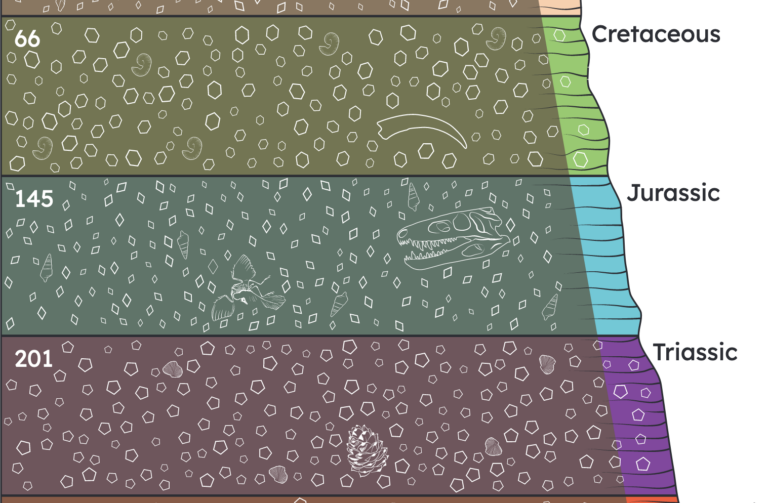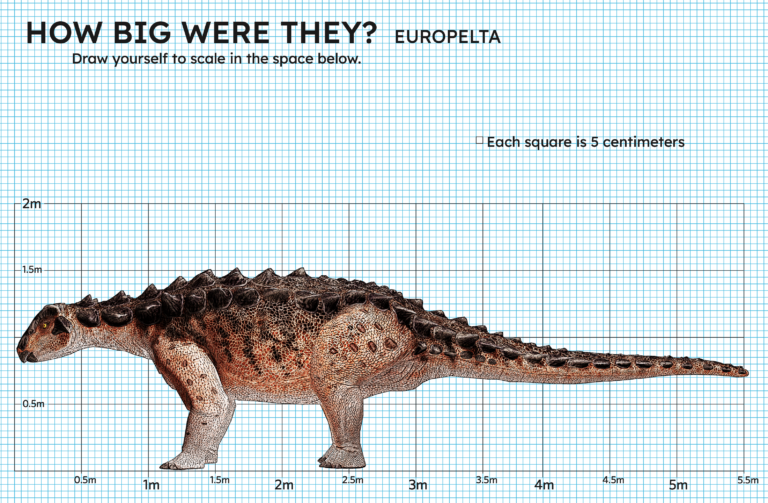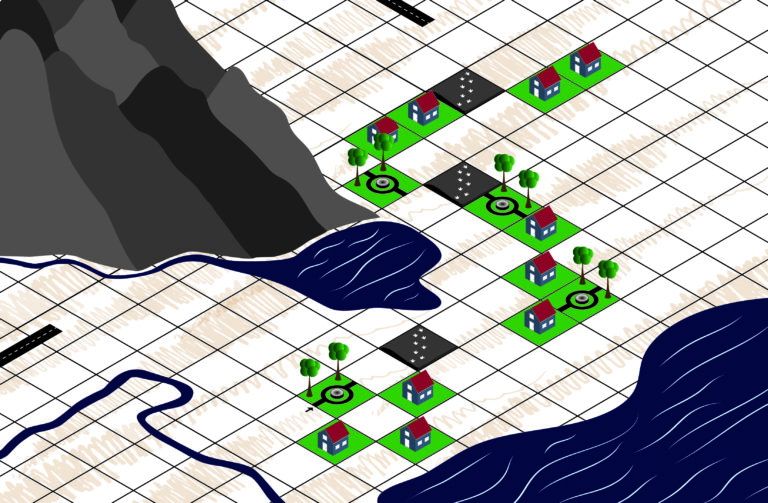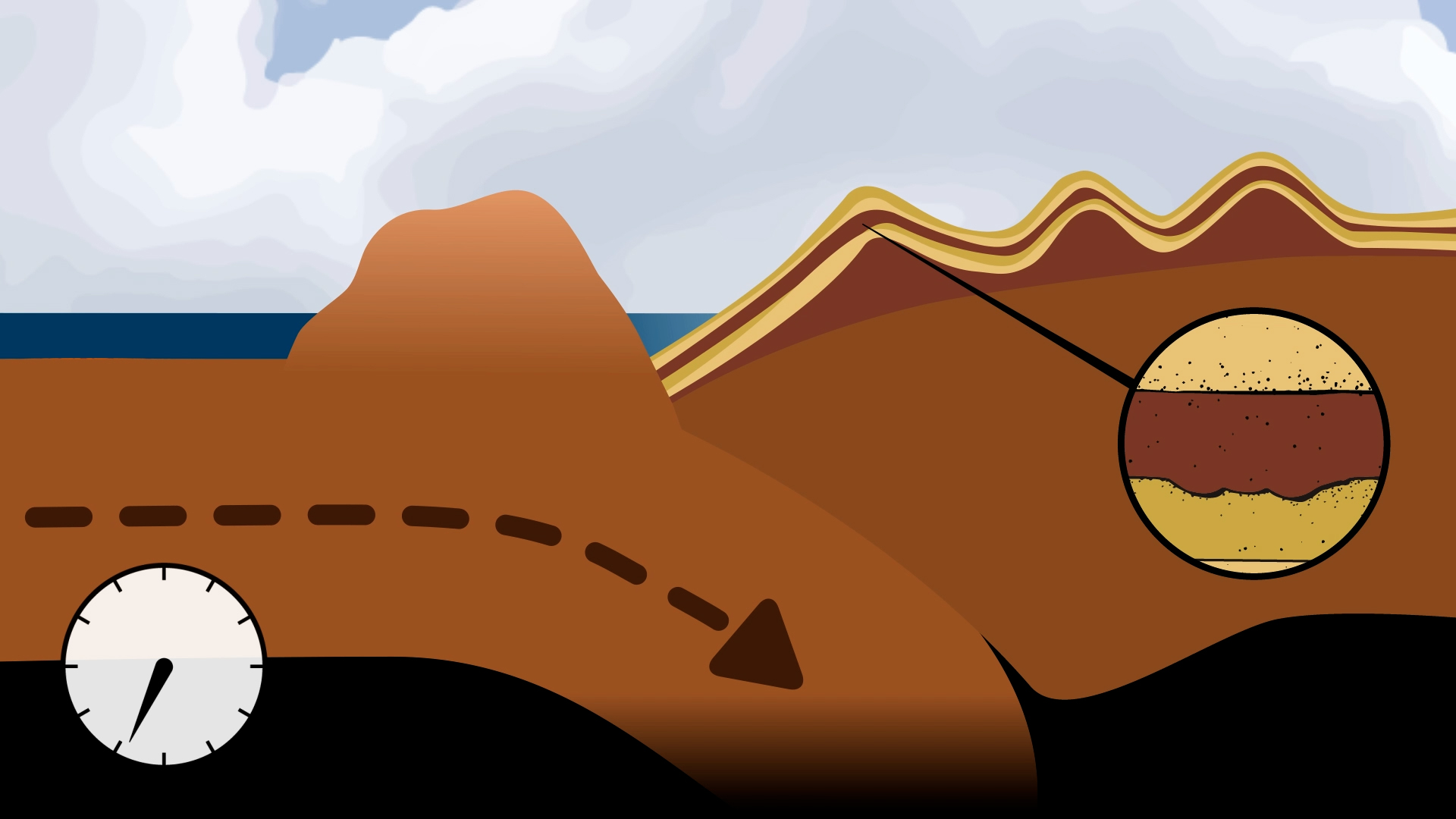Roadside Finds
You can find a fossil anywhere, even on the side of a highway! What kinds of creatures walked here, and what should you do if you find their fossils?
Questions to keep in mind
- How detailed are most fossils?
- Where can you find fossils?
- Do you think most fossils have already been found?
Good footprints, bad footprints
We know what dinosaurs looked like from their fossils. Different fossils tell us different kinds of information. Look closely to discover more.
Clues in the rocks
You find an amazing footprint, it’s so detailed you can even see the texture of the dinosaur skin! Sometimes you can also find clues that show you how a dinosaur was moving.
Lisa: Looking at ankylosaur footprints again. So we’ve got toe, toe, and it gets a little funky over here. Then the back of foot. There’s skin impressions.
Lisa traces around a fossilized partial ankylosaur footprint sticking out from a boulder next to a road.
Richard: Let’s take a look at the skin impressions.
Little bumps of skin texture are visible on the heel of the footprint.
Lisa: Lumpy texture right there and there’s also slide marks.
Richard: You can see exit striations.
Lisa traces her finger along several straight lines that are visible at the back of the footprint.
Lisa: So as the tubercles, the grips on the bottom of the dinosaur’s foot slid into the muck, it left these little grooves.
Richard: Skin impressions are, well, there are more people noticing them more now, but not too long ago, twenty-some years ago, there were only a few footprints, Cretaceous dinosaur footprints that had been found with skin impressions. So it’s always nice to see those.
What stepped here?
Ankylosaur fossils with different numbers of fingers and toes, and ankylosaur trackways with different numbers of fingerprints and toe prints have been found. How many fingers and toes does this species found in Europe have?
We're sorry! 3D content is only available when Javascript is enabled.


to explore
in and out
Have you heard of lumposaurs?
Lumposaur footprints are any dinosaur footprints that are so worn that they are hard to identify. Being a paleontologist can mean looking at a lot of lumpy rocks!
Lisa traces around a crescent-shaped lump protruding from a rock.
Richard: There, looks like there’s a handprint right over there. And it’s facing the other way. So the this footprint—can you point in the direction that footprint was going?
Another bump on the same rock is more distinctly foot-shaped.
Lisa: That way.
Lisa points away from the camera.
Richard: In the handprint here is going…
Lisa: That way.
Lisa points towards the camera.
Richard: That way. And, again, can you outline that one? Great. So there are the toes, and there’s a big crescentic back margin.
Lisa traces around the crescent lump again.
Lisa: This lump might be the footprint that goes with it, but hard to say.
Lisa points at an even less distinct bump behind the crescent-shaped lump.
Richard: You’re kind of lucky to… Usually, it always seems that if you have a good handprint, you have a pretty bad footprint or good footprint, you have a pretty bad handprint. So again, there’s another slab next to it that has some very worn footprints.
Another rock has a much smoother texture with several footprints that are more worn from erosion.
Lisa: Might be a couple of toes there
Richard: And over there, another slab with some prints, lumposaurs, not very good morphology.
The prints on this rock have no visible toes. They are just bumps.
Lumps to life

Cretaceous biodiversity
Dinosaurs weren't the only creatures around in the Cretaceous Period, the world was full of life! What other fossils will you find here?
Ancient plants
You find a detailed fossil of a plant with broad leaves from the Cretaceous Period, but ferns and conifers were more common at this time. Which are more common now?
Lisa points to a recessed leaf vein in a rock. A white overlay highlights the subtle structure.
Lisa: There, leaf vein there
Richard: Nice, and below that, there’s a bit of a log, there. You see the wood impressions.
Below the leaf, wood grain impressions run along the surface of the rock. A white overlay traces out these lines made from the wood.
Crocodiles in BC!
You spot an ankylosaur trackway in the rock, and Richard points out a crocodile track next to it. Crocodiles have long, inward-pointing claws. Can you see the two different tracks?
Richard: So right there is the crocodile track.
Looking up at a grey slate overhang, three parallel fossilized claw marks are visible protruding from the surface. An overlayed depth map highlights where the tracks are on the overhang. An image of a recently made crocodile track shows three similar marks in sand.
Richard: and over here, these are the little ankylosaur tracks.
Looking up at the same overhang, several small ankylosaur footprints protrude near the crocodile tracks.
Fossil burrows
Very slight bumps on the surface of a large grey rock are the casts of marine invertebrate burrows.
Lisa: Little burrows all over the place.
A large chunk of rock lays by the roadside. Lisa points to tiny bumps on its surface that are barely visible.
Richard: So those little tiny bumps on the surface or natural casts of invertebrate traces. So everything here is upside down the slab would have been oriented completely the other way, flipped over. That’s always something to keep in mind. It could have just as easily fallen track-side down.
Lisa: Yeah, then we would see nothing.
Richard: We would see nothing.
Which came first?

What is a nodosaur?
The footprints found here were mostly those of ankylosaurs. We know from the shape of the footprints that these were a type of ankylosaur called a nodosaur.
Dinosaurs crossing
Did ankylosaurs really walk along roads? No, but this shows you how big they were, and that you can find fossils in surprising places.
All about ankylosaurs
Lisa and Richard have seen a lot of ankylosaur footprints. What can we learn from them?
Looking up at a grey slate overhang, six small ankylosaur footprints protrude from the surface.
Richard: Over here, these are the little ankylosaur tracks.
Lisa: They’re so cute.
An overlayed depth map highlights where the tracks are on the overhang.
Richard: Yeah, those would have been a little ankylosaur that would have been about the size of a coffee table. A small coffee table. So, yeah, very interesting, very interesting site. So we’ve not described ankylosaur trackways that are this small.
How big were ankylosaurs?

Human impacts
The people who built the highway probably didn't know there were fossils. Without the road, the fossils may not have been found, but what was lost?
Look up!
The footprint fossils are found on the underside of a rock overhang on this cliff. Why do you think this makes them difficult, and dangerous, to study?
A black truck drives along a two-lane highway. A rocky cliff embraces the left of the road and a river gently flows by to the right.
Richard: So the, because it’s a cliff, it is sort of a dangerous site to approach.
A grey slate cliff face looms above. An overhang protrudes outward creating a covered spot beneath.
Richard: We’ve been to it and I’ve done some research on it. We took some 3D images of a number of tracks.
A multi-coloured scan of the overhang. The colours represent the depth of several protrusions on its surface.
Richard: Now the main focus is going to be on the underside of a ledge.
Looking directly up at the overhang from below several small protrusions are visible.
Richard: Like there’s an overhanging ledge at this cliff and it’s always good to take a look under these things.
Richard and Lisa sit in the front seat of a car as they drive down a road.
Richard: And I took a look under the ledges and noticed tracks under there and there’s some pretty interesting footprints and trackways.
Found a fossil?
What should you do to document it? Listen to Lisa and Richard to find out.
Richard and Lisa sit in the front seat of a car as they drive down a road.
Richard: But you never know what you’re gonna find when you check out these little road cuts. So it’s always good to take a look at them.
Standing on the side of the road, Lisa traces around a fossilized ankylosaur footprint with her finger.
Richard: And if you find something, don’t move it, take pictures, get GPS coordinates if you can, or at least distance and direction from the nearest town and report it to a paleontologist.
Lisa takes a picture of a fossilized bone. Richard holds a GPS as he writes in a yellow note book.
Lisa: Put something for scale in the photos, not your hand, because hands are all different shapes and sizes, not your foot, because same idea.
A blue fossilized bone sits next to a ruler. A four-toed ankylosaur footprint is pictured with a scale bar placed next to it.
Richard: Or a coin.
A three-toed theropod footprint is pictured with a scale bar placed next to it.
Lisa: A coin works. Ensure that you get a nice straight-down head on shot of the specimen. A couple of angle photos are okay but really want to see the details. You want the specimen or the fossil and you think you found center in the photograph.
A bony fish fossil is darker in colour than the grey rock it is embedded in. A fossilized spinal column and ribs of a marine reptile are lighter in colour than the grey rock it is embedded in.
Richard: Yeah, so the reason is, it’s when you remove the fossil from an area you’ve removed most of the scientific value of the fossil which is its context.
A brown mountain slope covered with loose rocky debris from erosion.
Richard: If we have location, we can tell what formation it’s from, and even where within the formation it’s from.
A river flows through a valley next to a tree-covered mountain.
Which route?

Geo facts | Past and present
Evidence of Earth’s past is embedded in its geology. Fossilized footprints, mudcracks, and sedimentary structures help us peer back in time. However, even now new events are being recorded in the Earth’s rocks.
Trace fossil formation
The journey from footprint to fossil is a long one. We’ve sped up the process to show how it happens otherwise we would never get to the end.
Animation. A three-toed dinosaur foot with sharp claws makes an impression in sand.
Sam: Most traces of life get washed away before they can become fossils. However, in the right conditions, these traces can be buried by sediments.
Water washes over the footprint. Layers of sand and soil fill in the footprint and continue to bury it deeper and deeper below the surface. As the camera zooms out more and more layers of sediment bury the footprint.
Sam: If enough sediment piles up over time, heat, pressure and chemical changes solidify the sediment and turn it into rock. This process is called lithification. These changes happen deep beneath the Earth's surface, where most of these rocks will remain buried.
The rocks layers start to move and bend. They are being uplifted to form a mountain.
Sam: Under the right tectonic conditions uplift can bring the rocks to the surface.
Erosion starts to wear away the rock layers from the top down. Eventually the fossilized footprint buried far below is exposed on the surface.Sam: Once on the surface, erosion from wind, rain, and ice breaks down the rock layers on top. This exposes the rock layers underneath and sometimes exposes trace fossils. Hi, my name is Sam Shekut. I'm a PhD candidate here at the University of British Columbia, where I study sedimentary geology.
Which way is up?
When it comes to rocks, up isn’t always what it used to be. Over time rocks can move, deform, and even completely overturn. So how can we know which way they used to face?
Sam: Which direction is up? This might seem like a silly question, but the answer isn't always obvious.
A river flows by a steep rocky hill. Layers of rock in the hill run vertical from top to bottom.
Sam: Rock layers can be tilted so much that the older layers are on top.
Looking upwards more layers of rock run vertically from the ground towards the sky.
Sam: Geologists call these overturned beds. Luckily, geologists and paleontologists have several tools to figure out if layered rock has been overturned.
Several examples of tilted layered rock are shown.
Sam: One tool is footprints and track fossils. The top side of these fossils will look like a depression, while the bottom side will look like raised bumps.
A grey rock with two fossilized three-toed dinosaur footprints. The footprints are bumps emerging from the rock.
Sam: The cracks that form when mud dries out often get preserved in the rock record. When we find mud cracks in old rocks. We know that the cracks open downwards.
A red layered rock with a fossilized mudcrack. The top of the crack is wide and tapers down to a point at the bottom.
Sam: When ice melts over a lake or ocean and drops a large rock onto a layer of soft silts, this is called a drop stone. The layers underneath the falling stone get bent and deform. As the rock gets buried the layers on top remain flat.
Sam: Root fossils are one of the best ways to find up. Roots always grow from the top and spread downwards.
Sam: Another tool is graded bedding. This forms when mixed sediments fall rapidly into water. The larger sediments settle out first and the finer grained sediments cover them over time. This leads to a finer grain size towards the top.
Present-day deposits
Even now, geological processes are happening! This river is an example of a depositional environment in action. The flow of a river continuously carries and deposits new sediment which may become rock.
The camera slowly pans across a landscape. A river runs through a forest. The leaves are changing on the trees making the canopy appear yellow.
Sam: New rocks are being made right now! Through the processes of deposition and lithification, new layers are always being added to the geological record. What kinds of sediment are being deposited here? Faster rivers can transport more sediment so they only leave behind deposits of larger rocks. Slower moving rivers might leave behind deposits of finer sand. This river is somewhere in between, so it leaves behind deposits of mixed gravel and sand. The wide, flat areas to either side of the river are called floodplains. This area only sees deposition when it rains so much that the river overflows. As the water level slowly settles, a deposit of fine silt will cover the floodplain.
Geologic processes








